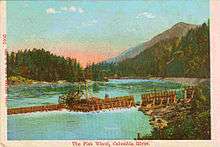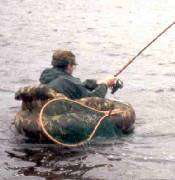Fish wheel

A fish wheel is a device for catching fish which operates much as a water-powered mill wheel. A wheel complete with baskets and paddles is situated on the river, usually upon a floating dock. The wheel rotates due to the current of the stream pressing the bottom basket or paddle that has swung down into the water. The baskets on the wheel, swinging downstream only at the speed of the current or more slowly, capture fish actively swimming upstream and also can capture fish simply drifting.
As baskets rise towards the top of the wheel, lifted by the force of the river, the fish are shunted to one side and out an opening in the side of the basket, by gravity. This happens because the basket's inside edge, along the axle, is tilted at an angle relative to the axle and forms a slide to one side when the basket rises to vertical, as if it were a children's play slide standing lengthwise upon the axle. Therefore, as the basket reaches and passes vertical, fish flow to the inside edge and then along the slide to the side, spilling out an opening on the side of the basket. A holding tank is placed beside the wheel to receive the falling fish. A harvester need only come by only a few times each day to remove and process caught fish from the holding tank.
The yield is increased if fish swimming upstream are channeled by weirs into the path of the baskets, as was done on the Columbia River in Oregon, by large commercial operations which harvested vast amounts of salmon in the early 20th century, until banned.[1] Fishwheels are operated in a different way by Tlingit Indians on the upper reaches of the Copper and Chilkat Rivers, harvesting salmon that are being pushed downstream by the current. In these settings the fish wheels harvest slowly and depend largely on luck to scoop under salmon resting in the current; more active means of harvest do far better.
Alaska
In Alaska, fish wheels are allowed only along the Copper River and the Yukon River. When not in operation, the wheels are lifted out of the water.
The wheels primarily catch salmon and can be owned by more than one person. All salmon caught using a fish wheel must be reported to the Alaska Department of Fish and Game (ADF&G) and must be operated within state fishing guidelines. The type of salmon caught varies with the time of year because not all salmon migrate and spawn at the same time. Summer season includes Chinook, summer chum, pink and sockeye salmon; Fall season includes fall chum and coho salmon. Typically, by the time a salmon reaches the fish wheels in the upper portion of the Yukon River, the fish are more mature and burning off fat to make the journey to the spawning grounds. The sockeye and Chinook salmon captured in fish wheels on the Copper River are considered good quality but are not migrating as far upstream before capture. Most chum salmon caught with fish wheels in the Yukon River are used as food for sled dogs. Yukon River salmon have the highest oil content of any stock because of the long distances they travel to spawn.
Columbia River fishery

Fish wheels were tremendously effective in the Columbia River around the turn of the 20th Century. One single fish wheel near The Dalles, referring to the long series of major rapids in the river, pulled 418,000 pounds of salmon out of the river in 1906 alone, and it was just one of more than 75 fish wheels working the river that year.
Conventional wisdom largely blames fish wheels for the decimation of the salmon run up the Columbia River in Oregon and Washington during the first few decades of the 20th Century. At the time, a bitter public-relations battle was fought between the gillnet fishing boat operators of the lower Columbia and the fish-wheel operators farther upstream; each group blamed the other for its dwindling salmon catch. In the 1908 Oregon election, the two sides sponsored competing ballot measures, one banning fish wheels and the other making gillnetting virtually illegal; both passed, but were thrown out by courts.[2]
Fish wheel operations on the Columbia were finally banned in 1928 (Oregon) and 1935 (Washington).[1] But by this time the Grand Coulee Dam had been built without fish ladders, cutting off access to many spawning grounds. This may be the reason the fishery has never rebounded to its historic levels.
Fish wheels in conservation
Fish wheels are also sometimes used for conservation purposes – for instance, to count or tag fish on a particular river – because they cause less damage to the fish they catch than other methods.[2]
See also
References
- 1 2 Columbia River Fish Wheel Oregon History Project, 2003.
- 1 2 Fish wheels making a comeback – to save fish Offbeat Oregon History, 1 November 2008.
External links
| Wikimedia Commons has media related to Fish wheels. |
- Photo allowing one to see how they actually work, pouring the catch to the side
- Photographs of historic Oregon fish wheels

